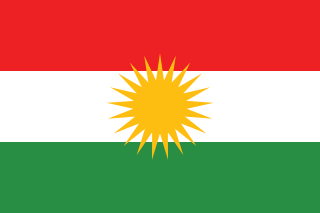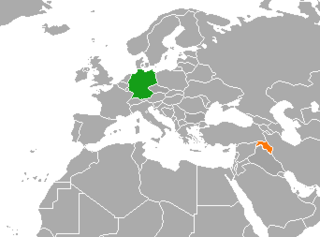
Iraqi Kurdistan or Southern Kurdistan refers to the Kurdish-populated part of northern Iraq. It is considered one of the four parts of Greater Kurdistan in West Asia, which also includes parts of southeastern Turkey, northern Syria, and northwestern Iran. Much of the geographical and cultural region of Iraqi Kurdistan is part of the Kurdistan Region (KRI), a semi-autonomous region recognized by the Constitution of Iraq. As with the rest of Kurdistan, and unlike most of the rest of Iraq, the region is inland and mountainous.

The Anfal campaign was a counterinsurgency operation which was carried out by Ba'athist Iraq from February to September 1988 during the Iraqi–Kurdish conflict at the end of the Iran–Iraq War. The campaign targeted rural Kurds because its purpose was to eliminate Kurdish rebel groups and Arabize strategic parts of the Kirkuk Governorate. The Ba'athist regime committed atrocities on the local Kurdish population, mostly civilians.

The Peshmerga are the armed forces of Iraqi Kurdistan, an autonomous region in northern Iraq. According to the Constitution of Iraq, regional governments are responsible for "the establishment and organization of the internal security forces for the region such as police, security forces, and guards of the region". Other Kurdish defence and security agencies include the Zêrevanî (gendarmerie), Asayish, and the Parastin û Zanyarî. The Peshmerga's history dates back to the 18th century, when they began as a tribal paramilitary border guard under the Ottoman Turks and the Safavid kurds. By the 19th century, they had evolved into a disciplined and well-trained guerrilla force.

Kurdistan Region (KRI) is a semi-autonomous federal region of the Republic of Iraq. It comprises four Kurdish-majority governorates of Arab-majority Iraq: Erbil Governorate, Sulaymaniyah Governorate, Duhok Governorate, and Halabja Governorate. It is located in northern Iraq, which shares borders with Iran to the east, Turkey to the north, and Syria to the west.

The 1991 Iraqi uprisings were ethnic and religious uprisings against Saddam Hussein's Ba'athist regime in Iraq that were led by Shia Arabs and Kurds. The uprisings lasted from March to April 1991 after a ceasefire following the end of the Gulf War. The mostly uncoordinated insurgency was fueled by the perception that Iraqi President Saddam Hussein had become vulnerable to regime change. This perception of weakness was largely the result of the outcome of the Iran–Iraq War and the Gulf War, both of which occurred within a single decade and devastated the population and economy of Iraq.

The Iraqi Kurdish Civil War was a civil war that took place between rival Kurdish factions in Iraqi Kurdistan during the mid-1990s, mostly between the Patriotic Union of Kurdistan and the Kurdistan Democratic Party. Over the course of the conflict, Kurdish factions from Iran and Turkey, as well as Iranian, Iraqi and Turkish forces, were drawn into the fighting, with additional involvement from American forces. Between 35,000 and 40,000 fighters and civilians were killed.

Kosrat Rasul Ali is a Kurdish politician and the leader of the Supreme Political Council of the Patriotic Union of Kurdistan (PUK), veteran Peshmerga military leader, former Prime Minister, and former Vice President of the Kurdistan Region.

The Kurdistan Democratic Party, usually abbreviated as KDP or PDK, is the ruling party in Iraqi Kurdistan and the senior partner in the Kurdistan Regional Government. It was founded in 1946 in Mahabad in Iranian Kurdistan. The party states that it combines "democratic values and social justice to form a system whereby everyone in Kurdistan can live on an equal basis with great emphasis given to rights of individuals and freedom of expression."

Nawshirwan Mustafa was an Iraqi Kurdish politician who served as the General Coordinator of the Movement for Change and the leader of the opposition in the Kurdistan Region from 1 April 2009 to his death on 19 May 2017.

The 1983–1986 Kurdish rebellions in Iraq occurred during the Iran–Iraq War as PUK and KDP Kurdish militias of Iraqi Kurdistan rebelled against Saddam Hussein as part of the Iraqi–Kurdish conflict, in an attempt to form an independent state. With Iraqi government forces occupied by the Iran-Iraq War, Kurdish Peshmerga succeeded in taking control of some enclaves, with Iranian logistic and sometimes military support. The initial rebellion resulted in stalemate by 1985.

The Iraqi–Kurdish conflict consists of a series of wars, rebellions and disputes between the Kurds and the central authority of Iraq starting in the 20th century shortly after the defeat of the Ottoman Empire in World War I. Some put the marking point of the conflict beginning to the attempt by Mahmud Barzanji to establish an independent Kingdom of Kurdistan, while others relate to the conflict as only the post-1961 insurrection by the Barzanis.
Balak, باڵەک, Balek is an ancient Kurdish tribe living in the former Soran Emirate which is now part of Erbil Governorate in Southern Kurdistan. it is located in the mountainous region of northern Erbil Governorate in Southern Kurdistan. People from the Balak area speak a language that is mixed in the Kurdish Sorani dialect and the Kurdish Kurmanji dialect.
The National Defense Battalions were an Iraqi Kurdish paramilitary and gendarmerie faction. They were initially a Kurdish pro-government militia used by Abdul-Karim Qasim during the First Iraqi–Kurdish War. Under Saddam Hussein, the NDB significantly increased in power and was incorporated into the government. It was very active in the Iran-Iraq War. Many of its members joined the Peshmerga during the 1991 Iraqi uprisings. Despite being weakened, the NDB survived until it was dissolved after the 2003 invasion of Iraq.
The Peshmerga have historically been Kurdish guerrilla forces combating the ruling powers in the region of what is now Iraqi Kurdistan. The term "Peshmerga" refers to those who face death, and the forces have long been an essential element in the Kurdish fight for autonomy and recognition.

Germany–Kurdistan Region relations are bilateral relations between Germany and Kurdistan Region. Germany has a consulate general in Erbil since 2012, and Kurdistan Region has a representation in Berlin since 1992. Many high-level meetings have been held between the two parties, including a visit to Berlin by Kurdish President Masoud Barzani in 2009, where he met with German Chancellor Angela Merkel and Foreign Minister Frank-Walter Steinmeier. In 2014, President Barzani described Germany as "one of Kurdistan Region’s staunch allies in the war against the Islamic State." German Consul General Marc Eichhorn described the relations as "excellent".

The Battle of Kirkuk, part of the 2017 Iraqi–Kurdish conflict, was a military deployment by the Iraqi Security Forces to retake Kirkuk Governorate from the Peshmerga after the latter ignored repeated warnings to withdraw, sparking clashes between the two forces. The advance began on 15 October 2017, with the city of Kirkuk being retaken the following day. Iraqi central government forces continued their advances in subsequent days, routing the Peshmerga forces across vast swathes of territory in northern Iraq.

The 2017 Iraqi–Kurdish conflict, also known as the Kirkuk crisis, was a conflict in which the Iraqi government retook disputed territories in Iraq which had been held by the Peshmerga since ISIL's Northern Iraq offensive in 2014. The conflict began on 15 October 2017 after tensions arising from the Kurdistan Region independence referendum of 25 September. The tension between the federal Iraqi government and Kurdistan Region escalated into conflict when the Peshmerga ignored repeated warnings to return Kirkuk to Iraqi government forces. Part of the conflict was the Battle of Kirkuk, when Iraqi forces routed Peshmerga forces from the city in a surprise dawn-offensive, marking the beginning of clashes.

The 1st Corps was a corps of the Iraqi Army, established before the Iran–Iraq War. It was located in Kurdistan Region.

Amna Suraka is a museum in Sulaymaniyah, Kurdistan Region of Iraq.
The Kurdistan Region–PKK conflict is a series of battles and clashes in Iraqi Kurdistan between the ruling Kurdistan Regional Government against the Kurdistan Workers' Party (PKK) and its allied groups. It started in 1983 and is still ongoing in the form of an insurgency. The PKK's primary method is using guerrilla warfare against the Peshmerga.















